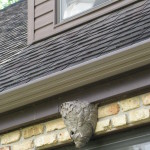As leaves tumble off our trees each fall we usually spot one or two round or football shaped gray wads of paper clinging to branches. They’ve been there all summer but hidden by leaves.
This fall many people will discover similar baldfaced hornet nests and be alarmed that they’re sharing their yard with stinging insects.
A fertile bald faced hornet queen overwinters under a log or in the ground. As the weather warms she flies to a branch and makes a tiny nest of paper-like material. She’ll lay an egg or two that hatches into a worker. Workers forage for tasty insect food and expand the nest. As the nest grows the queen lays more eggs until the colony has many hornets. By summer’s end it’s full size just before leaves begin to fall.
Bald Faced hornets are normally content to go about their business building their nest and catching tender insect food. They have little interest in stinging people unless someone molests their nest. Get too close or bother the nest and you likely will get stung many times. Dozens of hornets will instantly attack and multiple stings are the norm.
There’s a simple way to avoid being stung. Leave the nest alone. That may be easier said than done. A few years ago a neighbor teenager spotted a nest in a backyard tree. He hurled rocks at it, and his aim was good. Angry hornets boiled out and attacked! The boy retreated in pain but with an education he won’t forget.
As the weather cools the colony creates more queens that mate and then find a snug place to overwinter in solitude. Worker hornets die and the nest soon becomes empty and disintegrates during winter wind and snow.
If you find a hornet nest in early to mid-fall LEAVE IT ALONE. It may still be occupied. If it must be removed wait until cold weather sets in. By then it will be abandoned and can be removed safely. At Winding Pathways we leave our nests in place and gradually watch them disintegrate.


